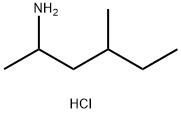4-Methyl-2-hexanamine hydrochloride
Synonym(s):DMAA;1,3-Dimethylamylamine hydrochloride;1,3-Dimethylpentanamine hydrochloride;1,3-Dimethylpentylamine hydrochloride;2-Amino-4-methylhexane hydrochloride
- CAS NO.:13803-74-2
- Empirical Formula: C7H18ClN
- Molecular Weight: 151.68
- MDL number: MFCD09038354
- EINECS: 687-991-9
- SAFETY DATA SHEET (SDS)
- Update Date: 2024-09-24 16:40:18

What is 4-Methyl-2-hexanamine hydrochloride?
Description
1,3-Dimethylpentylamine is a pseudo-adrenergic drug introduced by Lilly Company in the United States in the mid-1940s under the trade name Forthane. 1,3-dimethylpentylamine and its hydrochloride have obvious curative effects in the treatment of nasal congestion and gingival hyperplasia, and are much less stimulating to the mind than pseudoephedrine and amphetamine, and their unique pharmacological advantages cause attached great importance to the experts.
Chemical properties
White Solid
The Uses of 4-Methyl-2-hexanamine hydrochloride
Methylhexanamine (hydrochloride) is a simple aliphatic amine that was once marketed as a nasal decongestant (Forthane) but is now sold as a bodybuilding supplement (Floradrene, Geranamine). It is also sold as a mild stimulant in the form of party pills and has been reported to cause cerebral hemorrhage in a case report. While little is known about its mode of action, methylhexanamine interferes in immunoassays for amphetamines, presumably because of the common ethylamine structure. This compound is intended for forensic or research purposes.[Cayman Chemical]
The Uses of 4-Methyl-2-hexanamine hydrochloride
1,3-Dimethylpentylamine is useful in composition in treating hypertrophied and hyperplastic gums which showed a significant reduction in swelling.
General Description
4-Methyl-2-hexanamine hydrochloride is a psychoactive substance and has been found to be an inhibitor of serotonin uptake, which may be related to its ability to inhibit the function of the serotonin transporter. The amount of 4-methyl-2-hexanamine hydrochloride absorbed by the body varies depending on how it is taken. When taken orally, 4-methyl-2-hexanamine hydrochloride enters through the digestive tract and reaches high levels in the blood stream. When taken intravenously, it enters the bloodstream directly and can reach higher concentrations in the blood. When inhaled, 4-methyl-2-hexanamine hydrochloride can enter into the lungs at high concentrations and then is absorbed into the bloodstream. 4-Methyl-2-hexanamine hydrochloride also degrades quickly in natural environments due to its biodegradable properties.
Biochem/physiol Actions
Methylhexanamine is a naturally substance isolated from Pelargonium graveolen. It is a component of geranium oil. Methylhexanamine is a sympathomimentic that increase levels of norepinephrine in the synaptic cleft.
Synthesis
At
room temperature, 800 mL absolute ethanol was added into a 2 L three
neck flask, stirred, and 35.38 g (1.538 mol) of metal sodium was added
in batches to obtain a colorless transparent liquid. Cool slightly, add
200g (1.537 rnol) of ethyl acetoacetate, continue heating slowly, and
add 232g (1.693 mol) of 2-bromobutane drop under weak reflux. Continue
heating and react for 8 h at 80~84 ??. Stop heating, cool naturally to
room temperature, leave it still, filter by suction, and concentrate the
yellow green filtrate under reduced pressure to obtain 241.4 g of 1,3-Dimethylpentanamine Hydrochloride with light
yellow viscous solid in 84.3% yield.
Properties of 4-Methyl-2-hexanamine hydrochloride
| Melting point: | 128.0 to 132.0 °C |
| Flash point: | 9℃ |
| storage temp. | room temp |
| solubility | H2O: soluble5mg/mL (clear solution) |
| form | powder |
| color | white to beige |
| InChI | InChI=1S/C7H17N.ClH/c1-4-6(2)5-7(3)8;/h6-7H,4-5,8H2,1-3H3;1H |
| CAS DataBase Reference | 13803-74-2(CAS DataBase Reference) |
Safety information for 4-Methyl-2-hexanamine hydrochloride
| Signal word | Warning |
| Pictogram(s) |
 Exclamation Mark Irritant GHS07 |
| GHS Hazard Statements |
H302:Acute toxicity,oral H315:Skin corrosion/irritation H319:Serious eye damage/eye irritation H335:Specific target organ toxicity, single exposure;Respiratory tract irritation |
| Precautionary Statement Codes |
P261:Avoid breathing dust/fume/gas/mist/vapours/spray. P264:Wash hands thoroughly after handling. P264:Wash skin thouroughly after handling. P270:Do not eat, drink or smoke when using this product. P301+P312:IF SWALLOWED: call a POISON CENTER or doctor/physician IF you feel unwell. P302+P352:IF ON SKIN: wash with plenty of soap and water. P305+P351+P338:IF IN EYES: Rinse cautiously with water for several minutes. Remove contact lenses, if present and easy to do. Continuerinsing. |
Computed Descriptors for 4-Methyl-2-hexanamine hydrochloride
| InChIKey | ZKKBPHUAHARETG-UHFFFAOYSA-N |
| SMILES | C(C)(CC)CC(N)C.Cl |
New Products
Tert-butyl bis(2-chloroethyl)carbamate 4-Methylphenylacetic acid N-Boc-D-alaninol N-BOC-D/L-ALANINOL N-octanoyl benzotriazole 3-Morpholino-1-(4-nitrophenyl)-5,6-dihydropyridin- 2(1H)-one Furan-2,5-Dicarboxylic Acid DIETHYL AMINOMALONATE HYDROCHLORIDE 1,1’-CARBONYLDIIMIDAZOLE R-2-BENZYLOXY PROPIONIC ACID 1,1’-CARBONYLDI (1,2-4 TRIAZOLE) N-METHYL INDAZOLE-3-CARBOXYLIC ACID (2-Hydroxyphenyl)acetonitrile 4-Bromopyrazole 5-BROMO-2CYANO PYRIDINE 5,6-Dimethoxyindanone 5-broMo-2-chloro-N-cyclopentylpyriMidin-4-aMine 2-(Cyanocyclohexyl)acetic acid 4-methoxy-3,5-dinitropyridine 1-(4-(aminomethyl)benzyl)urea hydrochloride 2-aminopropyl benzoate hydrochloride diethyl 2-(2-((tertbutoxycarbonyl)amino) ethyl)malonate tert-butyl 4- (ureidomethyl)benzylcarbamate Ethyl-2-chloro((4-methoxyphenyl)hydrazono)acetateRelated products of tetrahydrofuran
You may like
-
 4-Methyl-2-hexylamine Hydrochloride CAS 13803-74-2View Details
4-Methyl-2-hexylamine Hydrochloride CAS 13803-74-2View Details
13803-74-2 -
 Methylhexanamine hydrochloride solution CAS 13803-74-2View Details
Methylhexanamine hydrochloride solution CAS 13803-74-2View Details
13803-74-2 -
 1975-50-4 98%View Details
1975-50-4 98%View Details
1975-50-4 -
 2-HYDROXY BENZYL ALCOHOL 98%View Details
2-HYDROXY BENZYL ALCOHOL 98%View Details
90-01-7 -
 2-Chloro-1,3-Bis(Dimethylamino)Trimethinium Hexafluorophosphate 221615-75-4 98%View Details
2-Chloro-1,3-Bis(Dimethylamino)Trimethinium Hexafluorophosphate 221615-75-4 98%View Details
221615-75-4 -
 14714-50-2 (2-Hydroxyphenyl)acetonitrile 98+View Details
14714-50-2 (2-Hydroxyphenyl)acetonitrile 98+View Details
14714-50-2 -
 118753-70-1 98+View Details
118753-70-1 98+View Details
118753-70-1 -
 733039-20-8 5-broMo-2-chloro-N-cyclopentylpyriMidin-4-aMine 98+View Details
733039-20-8 5-broMo-2-chloro-N-cyclopentylpyriMidin-4-aMine 98+View Details
733039-20-8


